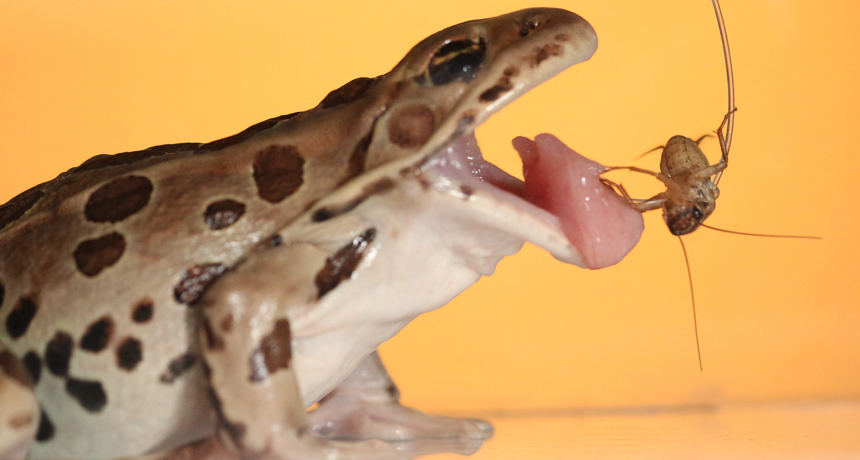Frog’s gift of grab comes from saliva and squishy tissue
A quick-switch saliva and softer-than-marshmallow tissue combine to help catch prey

A northern leopard frog nabs a cricket. Its tongue is made of squishy tissue and has special saliva that helps the frog hold onto its catch.
Candler Hobbs/Georgia Tech
By Susan Milius
Frogs’ have a remarkable power to tongue-grab prey as big as mice or as oddly shaped as tarantulas. How do they do this? The ability stems from a combo of peculiar saliva and a super-squishy tongue, new data show.
The first detailed analysis of the stickiness of frog saliva finds that the fluid can shift rather abruptly from gooey to runny, notes Alexis Noel. She is a mechanical engineer at Georgia Tech in Atlanta. Those quick changes come in handy during the various phases of a single tongue strike. And it all works because the tongue itself is so soft.
Internet videos of frogs feasting sparked Noel’s curiosity about their ability “to eat furry things, hairy things, slimy things,” she says. And, she adds, they do so with speed and power. A frog tongue strikes five times more quickly than a human can blink.
But a frog’s tongue is so soft that none of the standard tools on Noel’s campus could measure it without special modifications. The engineer eventually figured out that this tissue is as soft as a brain. And both the brain and tongue are softer than a marshmallow.
Noel and her colleagues shared their findings February 1 in the Journal of the Royal Society Interface.
Homing in on how the tongue nabs that prey
When a frog’s tongue shoots out at, say, a fly, the soft frog tissue splats on impact. It then spreads and curls around the prey. This action “massively increases the contact area” of frog tissue that can stick to the fly. That enhances its grip, Noel explains. Then frog saliva intensifies the effect.
The human mouth has salivary glands spread around inside. These glands drip saliva onto the tongue. Frog tongues, however, don’t depend on dripping glands. Instead, their saliva comes from glands inside the tongue itself. To see how sticky frog saliva might be, Noel spent several hours per sample scraping some 15 frog tongues to put together one fifth of a teaspoon of spit. That was what she needed for a single test.
Noel and her colleagues found that this saliva is what’s called a shear-thinning liquid. It grows thinner and easier to stir or smear around when force is applied. Smacking into a fly jolts saliva from its sticky phase into a more “liquidy” phase. That lets the fluid flow into all the small cracks on the insect’s body. As the tongue returns to the mouth, the spit thickens again. That makes the glue-like spit grip more strongly.
During that tongue jerk, acceleration can surge to 12 times the pull of Earth’s gravity. Still, in spite of the spit’s stickiness, the insect could be flung loose at this point, Noel calculated. But the soft stretchiness of the tongue lets it act like a natural bungee cord that retracts without too much of a jolt. And that prevents the loss of the prey, she concludes.
Once the fly is in the mouth, the tongue’s grip needs to loosen so that the fly can slide down the gullet. “Frogs actually use their eyeballs while swallowing,” Noel says. The eyeballs sink low into the head. From the outside they look as if they change from bulges to low bumps. Inside the head, they push the food toward the throat. The eyes’ impact jars the saliva into a runnier phase, easing its grip on the prey.
Frogs aren’t the only hunters that tongue-snatch their prey. Chameleon tongues also can be very sticky, notes Pascal Damman. He studies the physics of soft matter (including chameleon tongues) at the University of Mons in Belgium. The new findings remind him a bit of how chameleons catch prey using gooey mucus and a stretchy tongue, he says.







